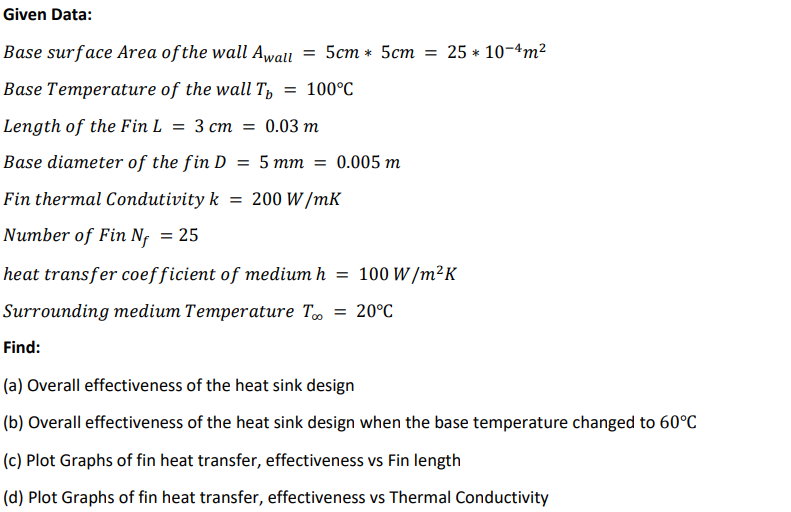A hot 5x5-cm² surface at base temperature Tb = 100°C is to be cooled by attaching 3-cm-long pin fins of parabolic profile with the base diameter of 5 mm. The fin is made of aluminum (k=200 W/mK) and there are 25 fins installed. The temperature of the surrounding medium is 20°C, and the convective heat transfer coefficient is assumed to be 100 W/m²K. a. Determine the overall effectiveness of the heat sink design. Please show all calculations. b. Calculate the effectiveness when the base temperature is changed to 60°C. What is the heat transfer by the heat sink? What can you conclude? c. Using Tb = 100°C, study the effect of changing the fin length (say to 4, 5, 6, 7, 8, and 9 cm) to the effectiveness. You do not need to show calculation here and you may use Excel or EES to perform the calculations. Plot the effectiveness and heat transfer by the heat sink versus fins length. What can you conclude? d. Using Tb = 100°C and fin length of 3 cm, study the effect of changing the thermal conductivity (say from 100 W/mK to 250 W/mK with interval of 50 W/mK) to the effectiveness. You do not need to show calculation here and you may use Excel or EES to perform the calculations. Plot the effectiveness and heat transfer by the heat sink versus thermal conductivity. What can you conclude?
A hot 5x5-cm² surface at base temperature Tb = 100°C is to be cooled by attaching 3-cm-long pin fins of parabolic profile with the base diameter of 5 mm. The fin is made of aluminum (k=200 W/mK) and there are 25 fins installed. The temperature of the surrounding medium is 20°C, and the convective heat transfer coefficient is assumed to be 100 W/m²K. a. Determine the overall effectiveness of the heat sink design. Please show all calculations. b. Calculate the effectiveness when the base temperature is changed to 60°C. What is the heat transfer by the heat sink? What can you conclude? c. Using Tb = 100°C, study the effect of changing the fin length (say to 4, 5, 6, 7, 8, and 9 cm) to the effectiveness. You do not need to show calculation here and you may use Excel or EES to perform the calculations. Plot the effectiveness and heat transfer by the heat sink versus fins length. What can you conclude? d. Using Tb = 100°C and fin length of 3 cm, study the effect of changing the thermal conductivity (say from 100 W/mK to 250 W/mK with interval of 50 W/mK) to the effectiveness. You do not need to show calculation here and you may use Excel or EES to perform the calculations. Plot the effectiveness and heat transfer by the heat sink versus thermal conductivity. What can you conclude?
Elements Of Electromagnetics
7th Edition
ISBN:9780190698614
Author:Sadiku, Matthew N. O.
Publisher:Sadiku, Matthew N. O.
ChapterMA: Math Assessment
Section: Chapter Questions
Problem 1.1MA
Related questions
Question

Transcribed Image Text:A hot 5x5-cm² surface at base temperature Tb = 100°C is to be cooled by attaching 3-cm-long pin fins of parabolic
profile with the base diameter of 5 mm. The fin is made of aluminum (k=200 W/mK) and there are 25 fins installed.
The temperature of the surrounding medium is 20°C, and the convective heat transfer coefficient is assumed to be
100 W/m²K.
a. Determine the overall effectiveness of the heat sink design. Please show all calculations.
b. Calculate the effectiveness when the base temperature is changed to 60°C. What is the heat transfer by
the heat sink? What can you conclude?
c.
Using Tb = 100°C, study the effect of changing the fin length (say to 4, 5, 6, 7, 8, and 9 cm) to the
effectiveness. You do not need to show calculation here and you may use Excel or EES to perform the
calculations. Plot the effectiveness and heat transfer by the heat sink versus fins length. What can you
conclude?
d. Using Tb = 100°C and fin length of 3 cm, study the effect of changing the thermal conductivity (say from
100 W/mK to 250 W/mK with interval of 50 W/mK) to the effectiveness. You do not need to show
calculation here and you may use Excel or EES to perform the calculations. Plot the effectiveness and
heat transfer by the heat sink versus thermal conductivity. What can you conclude?
Expert Solution
Step 1

Step by step
Solved in 5 steps with 10 images

Knowledge Booster
Learn more about
Need a deep-dive on the concept behind this application? Look no further. Learn more about this topic, mechanical-engineering and related others by exploring similar questions and additional content below.Recommended textbooks for you

Elements Of Electromagnetics
Mechanical Engineering
ISBN:
9780190698614
Author:
Sadiku, Matthew N. O.
Publisher:
Oxford University Press

Mechanics of Materials (10th Edition)
Mechanical Engineering
ISBN:
9780134319650
Author:
Russell C. Hibbeler
Publisher:
PEARSON

Thermodynamics: An Engineering Approach
Mechanical Engineering
ISBN:
9781259822674
Author:
Yunus A. Cengel Dr., Michael A. Boles
Publisher:
McGraw-Hill Education

Elements Of Electromagnetics
Mechanical Engineering
ISBN:
9780190698614
Author:
Sadiku, Matthew N. O.
Publisher:
Oxford University Press

Mechanics of Materials (10th Edition)
Mechanical Engineering
ISBN:
9780134319650
Author:
Russell C. Hibbeler
Publisher:
PEARSON

Thermodynamics: An Engineering Approach
Mechanical Engineering
ISBN:
9781259822674
Author:
Yunus A. Cengel Dr., Michael A. Boles
Publisher:
McGraw-Hill Education

Control Systems Engineering
Mechanical Engineering
ISBN:
9781118170519
Author:
Norman S. Nise
Publisher:
WILEY

Mechanics of Materials (MindTap Course List)
Mechanical Engineering
ISBN:
9781337093347
Author:
Barry J. Goodno, James M. Gere
Publisher:
Cengage Learning

Engineering Mechanics: Statics
Mechanical Engineering
ISBN:
9781118807330
Author:
James L. Meriam, L. G. Kraige, J. N. Bolton
Publisher:
WILEY